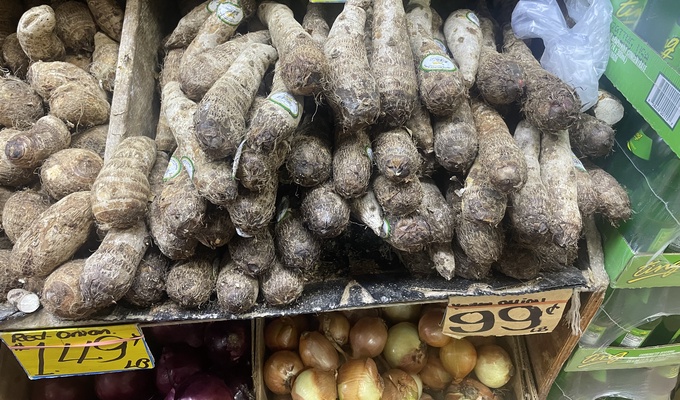Malanga, also called yautía, is the edible, starchy corm of the arrowleaf elephant ear (Xanthosoma sagittifolium), a species of tropical flowering plant. It is used in the cuisine of many Central American and Caribbean countries, under a variety of names.
Note that malanga is not the same as taro, though the two look quite similar. Malanga has a mild sweetness and a dry, starchy texture, while taro has more of a nutty flavor and a softer, slightly slimy texture.
In Puerto Rican and Dominican cuisine, where the plant and its corm are called yautía, it is used in pasteles, ground with squash, potato, green bananas and plantains into a dough-like fluid paste containing pork and ham, and boiled in a banana leaf or paper wrapper.
It is also used in local dishes such as guanime, alcapurrias, sancocho, and mondongo. In alcapurrias, it is also ground with green bananas and made into fried croquettes containing picadillo or seafood.
In Suriname and the Netherlands, the plant is called tayer. The shredded root is baked with chicken, fruit juices, salted meat, and spices in the popular Surinamese dish, pom. In Surinamese cuisine the leaves are also often baked with a Maggi-cube and eaten alongside rice and chicken or salted beef.
Note that malanga is not the same as taro, though the two look quite similar. Malanga has a mild sweetness and a dry, starchy texture, while taro has more of a nutty flavor and a softer, slightly slimy texture.
In Puerto Rican and Dominican cuisine, where the plant and its corm are called yautía, it is used in pasteles, ground with squash, potato, green bananas and plantains into a dough-like fluid paste containing pork and ham, and boiled in a banana leaf or paper wrapper.
It is also used in local dishes such as guanime, alcapurrias, sancocho, and mondongo. In alcapurrias, it is also ground with green bananas and made into fried croquettes containing picadillo or seafood.
In Suriname and the Netherlands, the plant is called tayer. The shredded root is baked with chicken, fruit juices, salted meat, and spices in the popular Surinamese dish, pom. In Surinamese cuisine the leaves are also often baked with a Maggi-cube and eaten alongside rice and chicken or salted beef.
